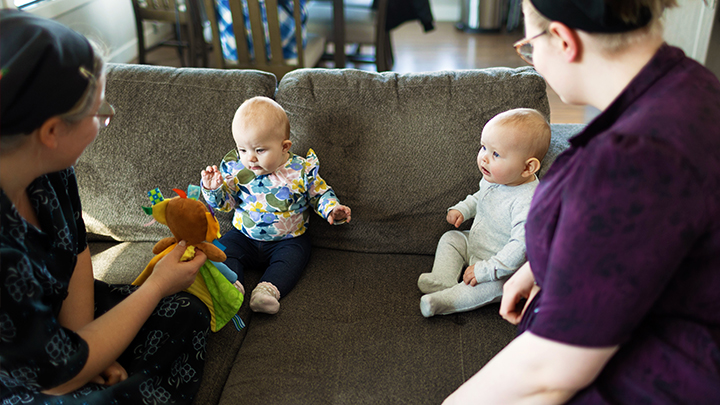
January 30, 2025

Members of the Low German Mennonite community enjoy some quality time with their young ones. Supplied.
Story by Jennifer Vanderlaan
Prenatal classes adapted to the cultural needs and values of the Low German Mennonite (LGM) community are now available in the South Zone.
Developed by Alberta Health Services (AHS) public health nurses Tammy Gamracy and Christy Martens — as well as Tina Meggison, AHS Community Health representative and Low German interpreter — the classes bridge gaps in prenatal knowledge, empower expectant mothers, and improve maternal and infant health outcomes.
“The LGM community is tightly-knit, and information is often based on generational knowledge and experiences,” says Meggison. “Offering this class to the community, in the way they can best understand it, better equips expectant mothers with accurate information so they can have safer, healthier pregnancies and births.”
Meggison grew up in the LGM community. As one of 12 children, she remembers helping her own mother navigate the medical system during her last high-risk pregnancy. Meggison did not know much about pregnancy as is common for children in this culture.
While accompanying her mother to her appointments, Meggison soon realized that despite her mother’s numerous pregnancies, she still lacked accessible and easily understood information about pre- and post-natal care, largely due to language barriers and cultural differences.
“That experience helped me to become the community health representative that I am today,” says Meggison. “Part of my job is to provide interpretation at appointments for clients and help them to navigate our medical system.”
Content for prenatal classes in Alberta is delivered in English and by pre- and post-natal team instructors. To get this information to the LGM community, Meggison knew they needed to receive it in their own language.
To ensure she was well-equipped to deliver the information, Meggison trained with the pre- and post-natal team before taking on the challenge of adapting existing course material to fit the needs of the community.
“Traditions are important to the community,” adds Meggison. “I wanted our classes to fit and honour those traditions while sharing important medical information about pregnancy and birth in a way the women can understand.”
Meggison kept the class slides in English and translated key information in a way that resonated with the community.
“We added lots of cultural images to support the text,” says Meggison. “This helped bridge the language-barrier gap that is often the biggest hurdle to accessing care for the LGM community.”
Teaching the women to connect the English word to the meaning gives them a better chance to understand what’s being said during their pre- and post-natal appointments, and when giving birth.
“This is how we empower women in the community — and better prepare them to make decisions about their body,” says Meggison.
Anna, a member of the LGM community, was excited to hear about the class. Although her grandmother, who supported labour and delivery in their community for many years, played a large role in educating her about pregnancy and birth, she was keen to learn more.
She attended her first prenatal class at 32-weeks pregnant.
“I learned so much,” says Anna. “Before this class, I always thought that I had to do what the doctors told me to do — but I learned in this class that I have more rights to my body than I thought — and that I could tell doctors what my plans were.”
This initiative represents a hopeful, inclusive approach to maternal healthcare, proving that when healthcare services are shaped to fit the needs of a community, they can foster lasting relationships to promote health and well-being for generations to come.
Lisa, also a member of the LGM community and mother of one, was preparing her mind and body for a second pregnancy. She found herself craving more information than what was available to her, so she jumped at the chance to attend the class.
“Having access to this information in a language we can understand is important because a lot of women don’t understand English,” says Lisa. “They sometimes go into pregnancy and birth without knowing what to expect.”
The introduction of prenatal classes for LGM women marks an exciting milestone, but it is only the beginning. Meggison says she hopes to expand programs to reach more families as well as add new topics based on community feedback.
“We have more than 30,000 LGM members in the South Zone,” adds Meggison. “Because many live in rural areas, it’s our goal to bring this class to them, because we want everyone who’s interested in attending to be able to do so.”